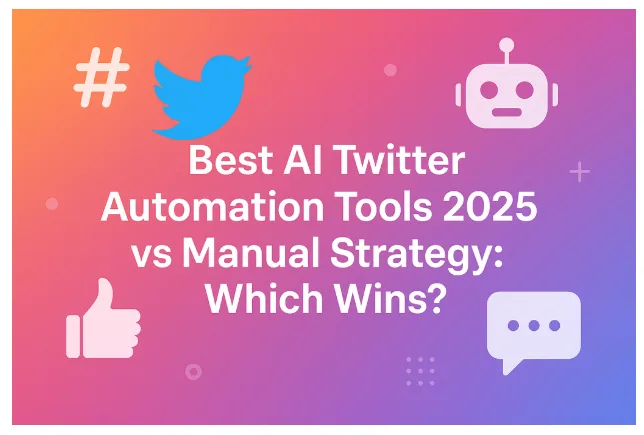Best AI Twitter Automation Tools 2025 vs Manual Strategy: Which Wins?
If you’re wondering whether automation or manual effort wins when it comes to managing your Twitter (X) presence in 2025, the answer is clear: automation takes the edge—especially when using advanced tools like Bika.ai—because it delivers greater consistency, scalability and efficiency, while manual strategy still plays a vital role for authenticity and real-time engagement.

What Defines the Best AI Twitter Automation Tools in 2025
When we talk about the “best AI Twitter automation tools 2025,” we mean platforms engineered for content generation, scheduling, engagement optimization and analytics—all with minimal manual overhead. Key capabilities include:
- Automatically generating tweets or threads based on prompts or trending topics.
- Scheduling posts at optimal times, handling recurring posts, and managing multiple accounts.
- Monitoring hashtags, audience behaviour, and analytics, for data-driven improvements.
- Ensuring account safety, compliance with X’s automation rules, and brand-voice control.
Tools like Bika.ai meet these standards—offering full automation from idea to posting without coding.
The Strengths and Weaknesses of Manual Twitter Strategy
Manual posting has long been the backbone of Twitter marketing: you craft each tweet, decide when to post, respond to comments in real time, and manage all engagement personally. The advantages of this approach include authentic voice, instant responsiveness, and the ability to adapt spontaneously to trends.
However, manual strategy also comes with significant drawbacks: it’s time-consuming, difficult to scale, prone to inconsistency, and often lacks the data-driven scheduling and optimization that automation offers. Performance-studies consistently show that manual workflows struggle with frequency and reliability at scale.
Performance Comparison: Automation vs Manual for Twitter Growth
When comparing AI automation tools with manual strategies in terms of performance, several metrics matter: engagement rate per post, follower growth, post frequency, time-to-post reaction, and scalability. Automation tools tend to dominate in these areas because they can maintain consistent publishing, target optimal times algorithmically, and free marketers to focus on strategy rather than execution. On the flip side, manual strategy still wins when it comes to real-time interactions, human tone, and reactive posting during live events. The best outcome isn’t a pure win of one over the other—it’s using automation for baseline consistency and manual for personal touch.
Why Bika.ai Elevates Your Twitter Automation Game
Among the automation tools available in 2025, Bika.ai stands out for several reasons. It combines AI-driven tweet generation with scheduling and posting automation in one seamless interface. With Bika.ai you can: input a prompt or topic, receive multiple tweet suggestions tailored for your brand voice, schedule or auto-post them, and track engagement—all without coding. It also supports multi-account workflows and built-in hashtag/trend optimisation—making it a full-stack solution for marketers looking to scale. The platform’s simplicity and power make it ideal whether you’re a solo creator or managing multiple campaigns.
How to Integrate Automation and Manual Strategies Effectively
While automation offers undeniable advantages, manual posting still has crucial value. The optimal strategy for marketers in 2025 is a hybrid approach:
- Use automation (e.g., Bika.ai) for evergreen content, recurring posts, frequent updates, and baseline engagement.
- Use manual posting for spontaneous reactions, interactive content (such as replies, live commentary, behind-the-scenes), and building human-driven relationships.
- Monitor analytics consistently—use data from automation to inform manual strategy and vice-versa.
By combining both methods you benefit from consistency and scale while preserving authenticity and adaptability.
Risks, Compliance and Authenticity Considerations for AI Automation
When embracing automation, marketers must be mindful of risks: over-automation can make content feel robotic, violate platform rules (leading to penalties), or lose brand tone. For example, automation should not replace real conversations or community building. Tools like Bika.ai guide users to combine AI suggestions with human review, maintain brand voice, and ensure compliance with X’s API or automation guidelines. Ultimately, maintaining authenticity is key—automation boosts efficiency, but human oversight preserves trust.
Future Outlook: Twitter Automation Tools and Manual Strategy in 2025 and Beyond
Looking ahead, the landscape of Twitter marketing will continue shifting toward smart automation: AI agents will handle multi-platform posting, adapt content based on engagement patterns, and suggest new topics based on audience sentiment. Manual strategy will still be needed for live events, personalized engagement and brand storytelling—but as automation becomes smarter, the baseline human effort will continue to drop. Marketers who embrace this shift, use tools like Bika.ai, and maintain flexibility will lead the pack.
Final Thoughts & Action Plan for Marketers
Automation wins the scalability and consistency race—especially when powered by tools like Bika.ai–but manual strategy remains essential for authentic engagement and agile responses. Here’s your action plan:
- Choose an AI automation tool (e.g., Bika.ai) and set it up for your baseline posting.
- Define your manual engagement tasks: live replies, trending topics, direct interaction.
- Use analytics from your automation tool to track what works and what doesn’t.
- Continuously refine your voice: ensure AI-generated content still feels like your brand.
- Scale gradually, balancing automation + human-driven effort for optimal growth.
By following this hybrid model, you harness the best of both automation and manual strategies—setting your brand up for consistent reach, deeper engagement and long-term success on Twitter in 2025 and beyond.
